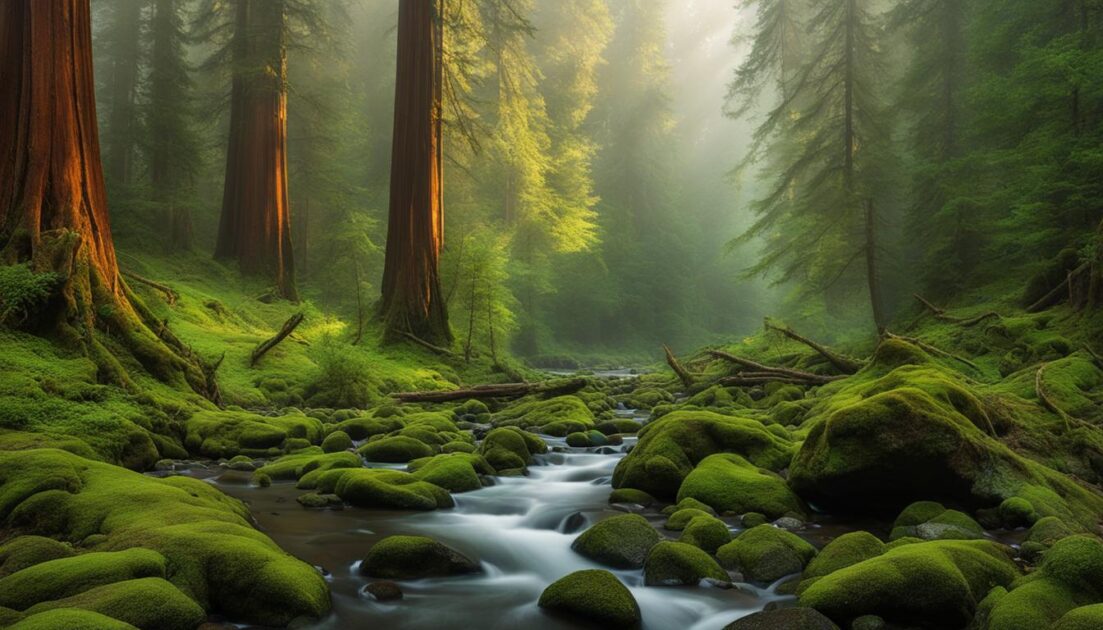Redwood National Park is known for its massive coastal redwood trees and stunning natural beauty. In this guide, I will provide you with all the information you need to plan your trip to Redwood National Park, including the weather conditions, key attractions, activities, best times to visit, hours and operations, RV parks and camping options, hotels and campsite accommodations, directions, history, nearby towns, and more.
Key Takeaways:
- Redwood National Park experiences a mild coastal climate with consistent weather throughout the year.
- The average temperature in Redwood National Park ranges from 50°F (10°C) to 70°F (21°C) during the summer and 40°F (4°C) to 60°F (16°C) during the winter.
- Be prepared for rain and bring appropriate clothing when visiting the park.
- Key attractions include the world’s oldest and tallest trees, picturesque coastline, and diverse wildlife.
- Activities in the park include hiking, camping, wildlife viewing, bird watching, and photography.
Weather Conditions in Redwood National Park

Redwood National Park experiences a mild coastal climate with relatively consistent weather throughout the year. The park is located along the northern California coast, where it receives a significant amount of rainfall, especially during the winter months. The average annual rainfall in Redwood National Park is around 60 inches (150 cm), contributing to the lush greenery and vibrant ecosystem that the park is known for.
The temperature in Redwood National Park varies throughout the year. During the summer months, from June to August, the average temperature ranges from 50°F (10°C) to 70°F (21°C). It is the warmest time of year, but it can still be cooler near the coast due to the influence of the Pacific Ocean. In the winter months, from December to February, the average temperature ranges from 40°F (4°C) to 60°F (16°C). It is important to note that temperatures can drop further during the evenings and nights, so it is advisable to bring layers of clothing for comfort.
When planning a visit to Redwood National Park, it is crucial to be prepared for rain and bring appropriate clothing. Weather patterns can be unpredictable, and rainfall can occur throughout the year. It is recommended to pack waterproof jackets, umbrellas, and sturdy shoes to navigate the park’s trails. Additionally, it is always a good idea to check the weather forecast before your trip and plan accordingly.
Annual Rainfall in Redwood National Park
| Month | Rainfall (inches) |
|---|---|
| January | 10 |
| February | 8 |
| March | 9 |
| April | 5 |
| May | 3 |
| June | 2 |
| July | 1 |
| August | 2 |
| September | 3 |
| October | 5 |
| November | 8 |
| December | 10 |
Key Attractions in Redwood National Park

If you’re planning a trip to Redwood National Park, you won’t want to miss out on its incredible attractions and must-see sights. From towering ancient redwood trees to picturesque coastlines, the park offers a range of natural wonders that will leave you in awe.
1. Ancient Redwood Trees
No visit to Redwood National Park would be complete without experiencing the majesty of the ancient redwood trees. These giants can reach heights of over 350 feet and have a lifespan of up to 2,000 years. Take a hike along the park’s scenic trails and immerse yourself in the awe-inspiring beauty of these living giants.
2. Coastal Landscapes
The park’s coastline is a sight to behold, with its rugged cliffs, rocky shores, and breathtaking ocean views. Explore the tide pool-filled beaches and discover a vibrant ecosystem teeming with marine life. Don’t forget to snap some photos of the jagged shores and crashing waves, as they provide the perfect backdrop for a memorable visit.
3. Wildlife Spotting
Redwood National Park is home to a diverse range of wildlife, offering visitors the opportunity to spot some fascinating creatures. Keep your eyes peeled for elk, foxes, eagles, and songbirds as you explore the park. If you’re lucky, you may even catch a glimpse of bears, deer, seals, sea lions, or whales along the coast.
4. Jedediah Smith Redwoods State Park
One of the designated areas within Redwood National Park, Jedediah Smith Redwoods State Park is a must-visit attraction. This park is home to Stout Grove, a grove of ancient redwoods that will transport you to a different world. Take a leisurely stroll through the towering forest and breathe in the fresh air while surrounded by these magnificent trees.
5. Del Norte Coast Redwoods State Park
Another gem within Redwood National Park, Del Norte Coast Redwoods State Park offers stunning coastal vistas and a chance to witness the power of nature. Don’t miss the opportunity to hike the Damnation Creek Trail, which takes you through lush forests to a breathtaking overlook of the Pacific Ocean.
These are just a few of the many incredible attractions that await you in Redwood National Park. Plan your visit carefully to ensure you make the most of your time and immerse yourself in the beauty of this unique natural wonder.
Activities and Things to Do in Redwood National Park
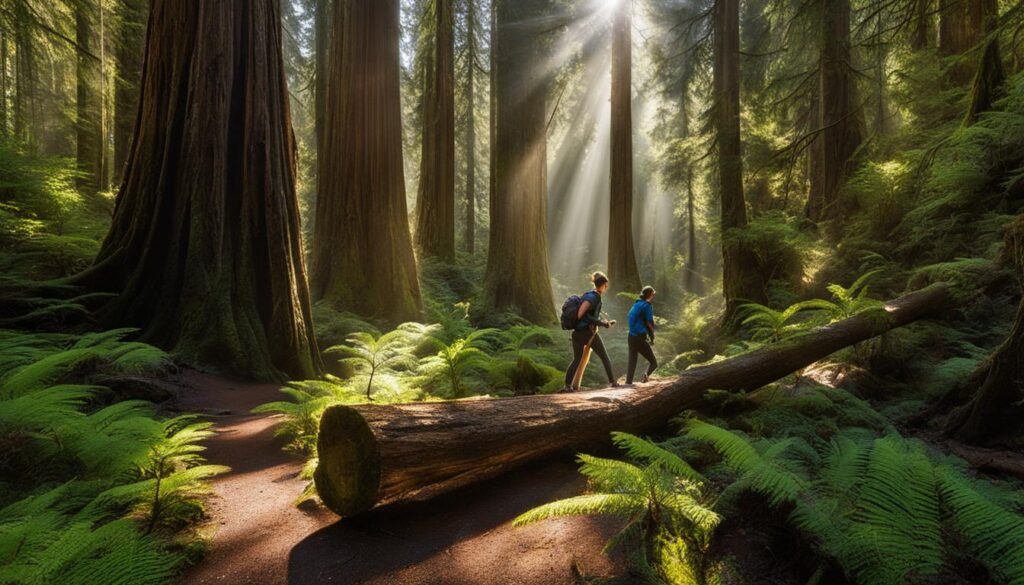
When visiting Redwood National Park, there is no shortage of activities and things to do that will allow you to fully immerse yourself in the park’s natural beauty. Whether you’re an outdoor enthusiast or simply looking for a peaceful retreat, Redwood National Park offers a diverse range of experiences to suit every interest and age group.
Hiking and Nature Trails
One of the most popular activities in Redwood National Park is hiking. With over 200 miles of trails, there are options for hikers of all skill levels. From easy walks through the towering redwoods to challenging multi-day backpacking trips, the park has something for everyone. Some of the must-see trails include the Tall Trees Grove, Lady Bird Johnson Grove, and the Coastal Trail, which offers breathtaking views of the Pacific Ocean.
Wildlife Viewing and Photography
Redwood National Park is home to a wide variety of wildlife, making it an ideal destination for wildlife enthusiasts and photographers. Keep an eye out for elk, eagles, foxes, songbirds, bears, and even whales along the coast. The park’s diverse ecosystem provides ample opportunities to capture stunning photographs of both the wildlife and the breathtaking landscapes.
Camping and Picnicking
For those looking to spend more time in the park, camping and picnicking are popular activities. The park offers several campgrounds with amenities such as picnic areas, restrooms, and fire pits. Camping allows you to fully immerse yourself in the serene surroundings and experience the park’s tranquility after the day-trippers have left. Pack a picnic and enjoy a meal surrounded by the towering redwoods or along the beautiful coastline.
Additionally, fishing, bird watching, and guided tours are also available in the park, providing further opportunities to explore and connect with nature. Be sure to check the park’s regulations and obtain any necessary permits or licenses before engaging in these activities.
| Activity | Description |
|---|---|
| Hiking | Explore over 200 miles of trails, ranging from easy walks to challenging backpacking trips. |
| Wildlife Viewing | Spot elk, eagles, foxes, songbirds, bears, and even whales along the coast. |
| Photography | Capture stunning photographs of the park’s wildlife and landscapes. |
| Camping | Immerse yourself in nature by camping in one of the park’s campgrounds. |
| Picnicking | Enjoy a meal surrounded by the towering redwoods or along the beautiful coastline. |
Best Times to Visit Redwood National Park

When planning a trip to Redwood National Park, it’s important to consider the best times to visit in order to make the most of your experience. The park offers different attractions and activities throughout the year, each season showcasing its own unique beauty. Whether you prefer a bustling atmosphere or a more peaceful retreat, here’s a guide to help you plan your visit during the peak and off-peak seasons.
Peak Season (May to September)
The peak season in Redwood National Park occurs from May to September, coinciding with the warmer summer months. During this time, the weather is mild and conducive to outdoor activities such as hiking, camping, and wildlife viewing. The park is bustling with visitors from all over the world, and popular attractions may be more crowded. However, the bustling atmosphere also means that there are more guided tours, educational programs, and events available for visitors to enjoy. If you don’t mind sharing the trails and attractions with fellow nature enthusiasts, the peak season can offer a vibrant and lively experience in Redwood National Park.
Off-Peak Season (October to April)
If you prefer a quieter and more secluded experience, the off-peak season in Redwood National Park is the ideal time to visit. From October to April, the park sees fewer visitors, allowing you to explore its wonders in a more peaceful setting. During the off-peak season, you can enjoy the tranquility of the ancient forests, spot wildlife without the crowds, and take in the stunning landscapes with uninterrupted solitude. While the weather may be cooler and rainier during this time, the lush greenery and misty atmosphere create a truly enchanting ambiance. It’s important to come prepared with appropriate clothing and gear to ensure a comfortable and enjoyable visit during the off-peak season.
Choosing the Best Time for You
When deciding the best time to visit Redwood National Park, consider your preferences and priorities. If you enjoy a vibrant and bustling atmosphere, and you want to take advantage of the park’s full range of activities and events, the peak season may be the right choice for you. On the other hand, if you prefer a more serene and secluded experience, and you’re willing to brave cooler temperatures and potential rain showers, the off-peak season offers a unique and tranquil visit to the park. Ultimately, the best time to visit depends on your personal preferences and what you hope to experience during your trip to Redwood National Park.
Hours and Operations in Redwood National Park
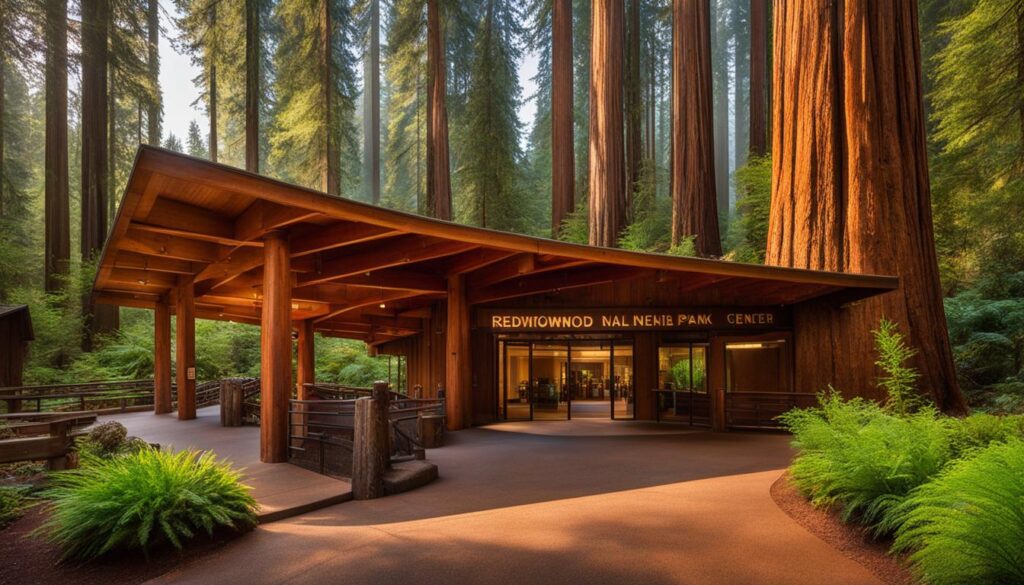
When planning your visit to Redwood National Park, it’s important to be aware of the park’s hours and operations. The park is open year-round, allowing visitors to explore its natural wonders in every season. However, it is crucial to note that specific hours and operations may vary for different facilities within the park.
The park offers five visitor centers where you can obtain information, maps, and permits. These visitor centers are not only a great resource for planning your visit, but they also provide exhibits and educational programs that allow you to delve deeper into the park’s history and ecosystem.
To ensure you have the most up-to-date information for your trip, it is recommended to check the official website of Redwood National Park or contact the park directly. They will provide you with accurate details on hours, guided tours, and any temporary closures or restrictions that may be in place during your visit.
With this information in hand, you can plan your itinerary accordingly and make the most of your time exploring the stunning beauty of Redwood National Park.
Visitor Centers in Redwood National Park
Redwood National Park offers a variety of visitor centers that serve as gateways to the park’s natural wonders. Here are the five visitor centers located within the park:
- Kuchel Visitor Center: Situated near Orick, California, this center offers exhibits on the park’s history, natural resources, and recreational opportunities.
- Prairie Creek Visitor Center: Located in the Prairie Creek Redwoods State Park, this center provides information on park trails, wildlife, and ecology.
- Jedediah Smith Visitor Center: Found in the Jedediah Smith Redwoods State Park, this center offers exhibits on the park’s ancient forests and diverse wildlife.
- Crescent City Information Center: Situated in Crescent City, California, this center provides information on both Redwood National Park and the nearby Del Norte Coast Redwoods State Park.
- Simpson-Reed Discovery Center: Located near Hiouchi, California, this center features interactive exhibits on the redwood ecosystem and cultural history.
These visitor centers serve as valuable resources during your visit, providing you with all the necessary information to make the most of your time in Redwood National Park.
| Visitor Center | Address | Hours | Contact Information |
|---|---|---|---|
| Kuchel Visitor Center | 1111 Second Street, Crescent City, CA 95531 | 9am – 5pm, Daily (Closed Thanksgiving, Christmas, and New Year’s Day) | (707) 465-7335 |
| Prairie Creek Visitor Center | 127011 Newton B. Drury Scenic Parkway, Orick, CA 95555 | 9am – 5pm, Daily (Closed Thanksgiving, Christmas, and New Year’s Day) | (707) 464-6101 |
| Jedediah Smith Visitor Center | 9 Avenue of the Giants, Hiouchi, CA 95531 | 9am – 5pm, Daily (Closed Thanksgiving, Christmas, and New Year’s Day) | (707) 464-6101 |
| Crescent City Information Center | 1111 Second Street, Crescent City, CA 95531 | 9am – 5pm, Daily (Closed Thanksgiving, Christmas, and New Year’s Day) | (707) 465-7335 |
| Simpson-Reed Discovery Center | 1111 Second Street, Crescent City, CA 95531 | 9am – 5pm, Daily (Closed Thanksgiving, Christmas, and New Year’s Day) | (707) 465-7335 |
RV Parks and Camping in Redwood National Park
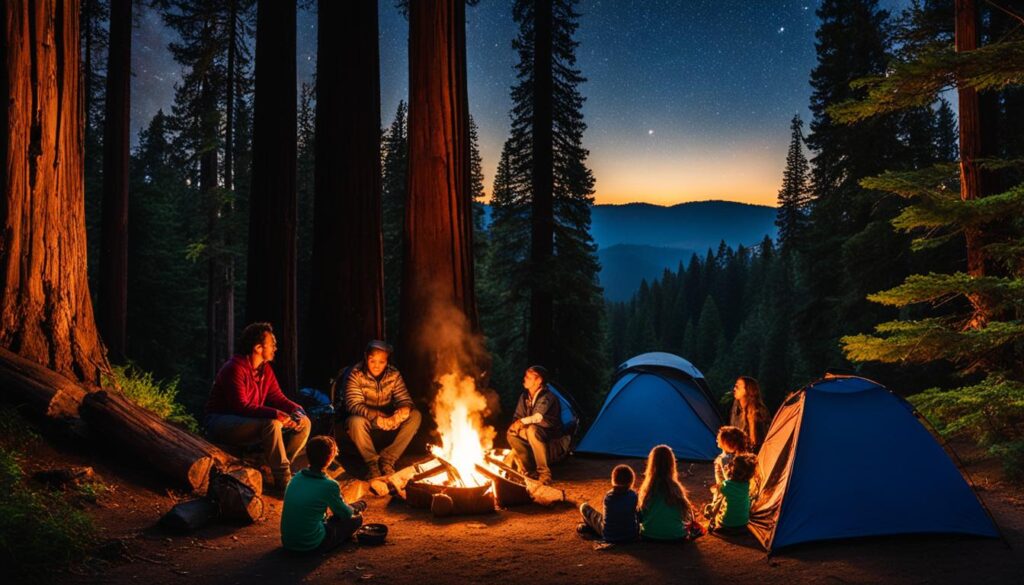
When planning a visit to Redwood National Park, camping is an excellent option for immersing yourself in nature. The park offers several campgrounds, each with its own unique features and amenities. Whether you prefer tent camping or RV camping, there are plenty of options to choose from.
If you’re traveling in an RV, you’ll be pleased to know that Redwood National Park has designated RV camping areas. These areas provide spaces for RVs of various sizes, ensuring a comfortable and convenient stay. Some RV parks even offer hookups for water and electricity.
For those who prefer traditional tent camping, there are numerous campgrounds to choose from within the park. Each campground offers a different experience, whether you’re looking for a secluded spot in the forest or a camping area near the beach.
Exploring the beauty of Redwood National Park by camping allows you to fully experience the serenity and tranquility of the surroundings. Waking up to the sounds of birds chirping and the scent of fresh pine in the air is truly a magical experience.
Table: Campgrounds in Redwood National Park
| Campground | Location | Amenities |
|---|---|---|
| Jedediah Smith | Located in the northern section of the park | Restrooms, picnic areas, fire rings |
| Mill Creek | Located in the southern section of the park | Restrooms, picnic areas, fire rings, access to hiking trails |
| Elk Prairie | Located in the central section of the park | Restrooms, picnic areas, fire rings, visitor center |
| Gold Bluffs Beach | Located on the coast of the park | Restrooms, picnic areas, fire rings, beach access |
It is highly recommended to make reservations in advance, especially during the peak season. Campgrounds in Redwood National Park can fill up quickly, and a reservation will ensure that you have a spot waiting for you upon arrival.
Whether you choose to camp in an RV or a tent, camping in Redwood National Park is an unforgettable experience that allows you to connect with nature and create lasting memories.
Hotels, Campsites, and Cabins in Redwood National Park
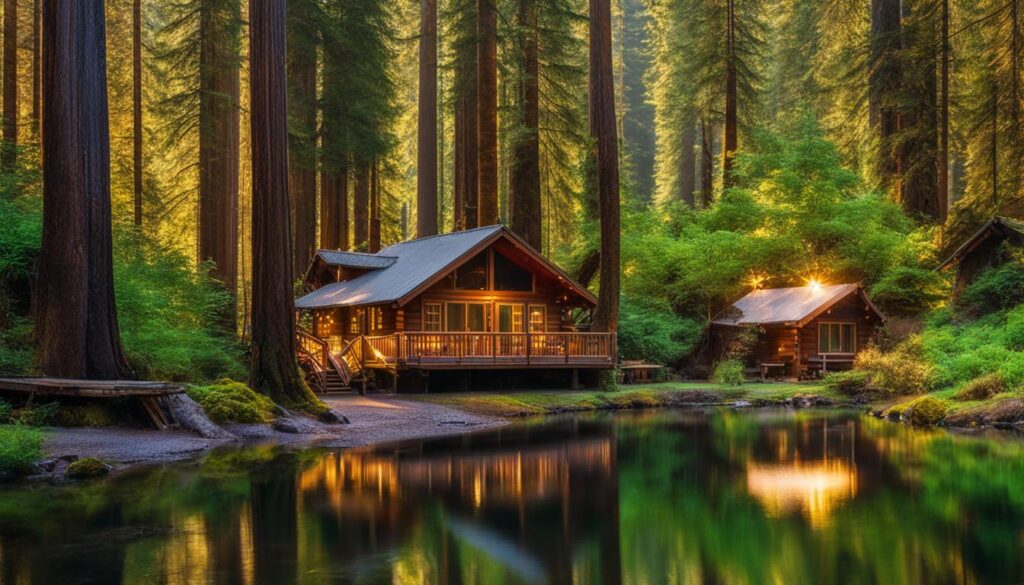
If camping is not your preferred option, there are various accommodations available near Redwood National Park. From cozy hotels to picturesque campsites and rustic cabins, there is something to suit every traveler’s preference and budget.
Hotels near Redwood National Park: There are several hotels located near Redwood National Park, offering convenient access to the park’s attractions. These hotels provide comfortable rooms, modern amenities, and often stunning views of the surrounding natural beauty. Some popular options include [Hotel 1], [Hotel 2], and [Hotel 3]. These hotels offer a range of amenities such as on-site restaurants, swimming pools, and complimentary breakfast.
Campsites near Redwood National Park: For those who want to immerse themselves in nature, there are numerous campsites located near Redwood National Park. These campsites provide a unique opportunity to experience the park’s pristine wilderness up close. Some recommended campsites include [Campsite 1], [Campsite 2], and [Campsite 3]. These campsites offer facilities such as picnic areas, fire pits, and restroom facilities.
Cabins in Redwood National Park: For a more rustic and secluded experience, cabins are available for rent within Redwood National Park. These cabins offer a peaceful retreat surrounded by towering redwoods and tranquil nature. Some popular cabin options include [Cabin 1], [Cabin 2], and [Cabin 3]. These cabins provide basic amenities and a cozy atmosphere for a memorable stay in the park.
Lodging Options Comparison
| Accommodation Type | Key Features | Location | Price Range |
|---|---|---|---|
| Hotels | Modern amenities, on-site restaurants, swimming pools | Near Redwood National Park | $$-$$$ |
| Campsites | Picnic areas, fire pits, restroom facilities | Near Redwood National Park | $ |
| Cabins | Secluded, surrounded by nature, basic amenities | Within Redwood National Park | $$ |
Planning Your Visit to Redwood National Park
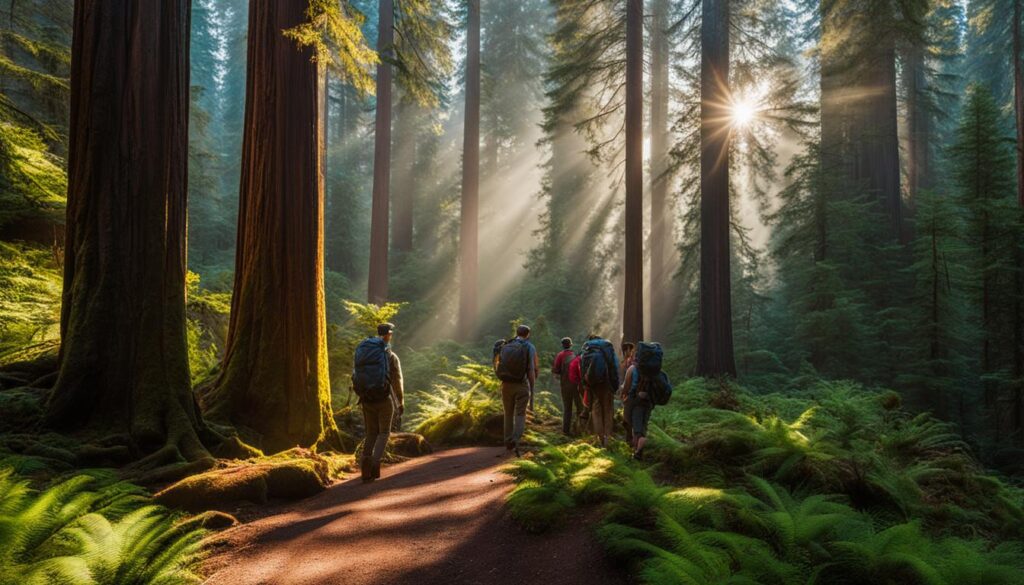
When planning a visit to Redwood National Park, there are a few key tips and things to know that will help make your experience enjoyable and memorable. Whether you’re a nature enthusiast, a photography lover, or simply looking to explore one of the most iconic national parks in the United States, careful planning will ensure a smooth and rewarding trip.
First and foremost, it’s important to consider the weather conditions in Redwood National Park. The park experiences a mild coastal climate with significant rainfall, especially during the winter months. Pack appropriate clothing to stay comfortable in varying temperatures and be prepared for rain. It’s also recommended to bring hiking gear, insect repellent, sunscreen, and a reusable water bottle to stay hydrated on the trails.
Before visiting the park, familiarize yourself with the park regulations, including the Leave No Trace principles. These guidelines promote responsible outdoor ethics, emphasizing the importance of leaving natural spaces unaltered and preserving the park for future generations. By following these principles, you can help protect the delicate ecosystem of Redwood National Park and ensure its beauty is preserved for years to come.
Additionally, it’s essential to check the park’s website for any updates on closures, road conditions, and safety information. Redwood National Park is open year-round, but specific hours and operations may vary for different facilities within the park. Be sure to check the official website or contact the park for the most up-to-date information on visitor centers, guided tours, and any temporary closures or restrictions.
Lastly, when planning your visit, consider the duration of your stay and the activities you’re interested in. Redwood National Park offers a range of outdoor activities, including hiking, camping, wildlife viewing, and photography. Research the different trails and attractions in the park to determine which ones align with your interests and fitness level. It’s also recommended to make campground reservations or book accommodations in nearby towns in advance, especially during the peak season.
Key Tips for Visiting Redwood National Park:
- Check the weather conditions and pack appropriate clothing
- Familiarize yourself with park regulations, including Leave No Trace principles
- Stay updated on closures, road conditions, and safety information through the park’s website
- Plan your activities and make campground reservations or book accommodations in advance
Directions to Redwood National Park
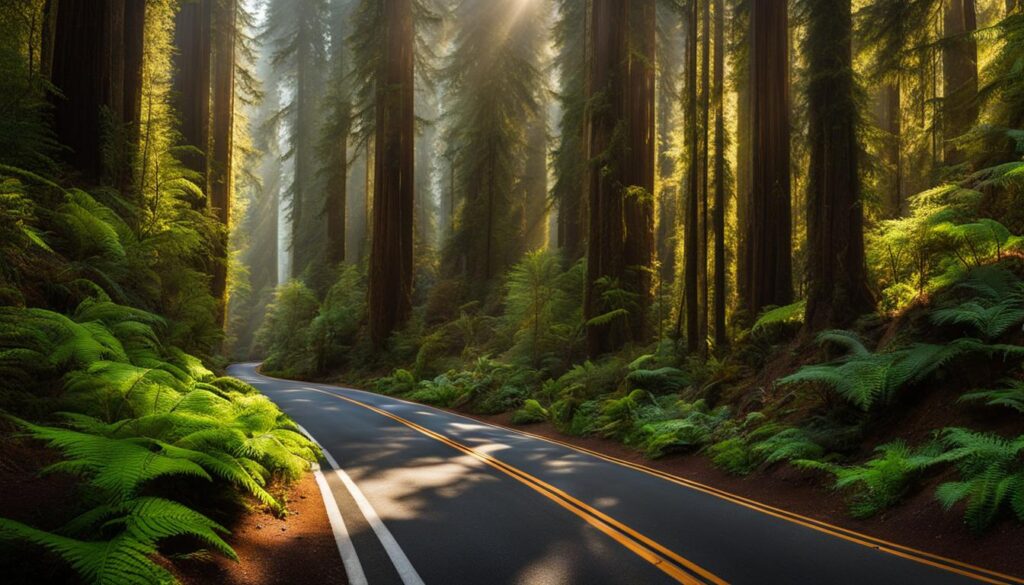
Getting to Redwood National Park is relatively straightforward, and there are several transportation options available.
Driving
The most common way to reach Redwood National Park is by car. The park is located along Highway 101 in Northern California. If you are coming from the south, you can take Highway 101 North, and if you are coming from the north, you can take Highway 101 South. The park is approximately 6 hours away from both San Francisco and Portland.
If you are using GPS or maps for directions, simply enter “Redwood National Park” as your destination, and it will guide you to the park entrance. Along the way, you will enjoy scenic drives and breathtaking views of the coastline.
Public Transportation
While there is no direct public transportation to Redwood National Park, you can take a bus or train to nearby cities such as Eureka or Crescent City and then rent a car or book a shuttle service to reach the park. There are also small regional airports in the area, but the closest major airports are in Medford (3 hours away) and Sacramento, Oakland, or San Francisco (all 6 hours away).
It is recommended to check the schedules and availability of public transportation options in advance, as they may vary depending on the season and demand.
Directions from Major Cities
| City | Driving Time to Redwood National Park |
|---|---|
| San Francisco, CA | Approximately 6 hours |
| Portland, OR | Approximately 6 hours |
| Sacramento, CA | Approximately 6 hours |
| Eureka, CA | Approximately 1 hour |
These driving times are approximate and may vary depending on traffic, road conditions, and the route you choose to take.
Having your own vehicle will provide more flexibility and convenience when exploring the park and its surrounding areas. Whether you choose to drive, take public transportation, or fly to a nearby airport, Redwood National Park is well worth the journey.
History of Redwood National Park
The establishment of Redwood National Park is rooted in a rich history of conservation and preservation. The efforts to protect the majestic redwood trees began in the 1920s with the establishment of partnered state parks. These state parks, along with the federal land of Redwood National Park, work together to safeguard half of the world’s old-growth redwoods.
Environmental activists and organizations played a crucial role in the establishment and ongoing conservation efforts of the park. Their tireless dedication and advocacy helped preserve this unique ecosystem for future generations to appreciate and cherish.
“Redwood National Park stands as a testament to the power of environmental activism and the importance of protecting our natural heritage.”
Today, Redwood National Park serves as a sanctuary for ancient forests and a diverse range of wildlife. It offers visitors the opportunity to immerse themselves in the awe-inspiring beauty of towering redwood trees, explore pristine coastlines, and witness the incredible resilience of nature.
The Establishment of Redwood National Park
The establishment of Redwood National Park as a national park took place in 1968. It was a significant milestone in the ongoing efforts to protect and preserve these magnificent trees. The combined efforts of federal and state authorities, environmental activists, and concerned citizens paved the way for the creation of this extraordinary national park.
Conservation Efforts in Redwood National Park
Conservation efforts in Redwood National Park focus on maintaining the delicate balance between preserving the ancient redwood forests and providing recreational opportunities for visitors. Sustainable practices, such as carefully managed trails, educational programs, and community involvement, contribute to the park’s long-term preservation efforts.
| Year | Event |
|---|---|
| 1920s | Establishment of partnered state parks to protect the redwoods |
| 1968 | Redwood National Park established as a national park |
| 1978 | Redwood National Park designated as a UNESCO World Heritage Site |
Conclusion
In conclusion, planning a trip to Redwood National Park is a must for nature enthusiasts. With its awe-inspiring redwood trees, breathtaking coastlines, and abundant wildlife, the park offers a truly unique experience. By following this guide, you can ensure that your trip is well-organized and memorable.
As you explore Redwood National Park, take the time to immerse yourself in the beauty of the ancient forests and capture the stunning landscapes through photography. Be prepared for the park’s mild coastal climate and bring appropriate clothing, especially during the rainy season.
Whether you choose to hike, camp, or simply marvel at the wonders of nature, Redwood National Park is sure to leave you in awe. Plan your visit carefully, familiarize yourself with park regulations, and make the most of your time in this extraordinary destination. Happy exploring!
FAQ
What is the weather like in Redwood National Park?
Redwood National Park experiences a mild coastal climate with relatively consistent weather throughout the year. The average temperature ranges from 50°F (10°C) to 70°F (21°C) during the summer and 40°F (4°C) to 60°F (16°C) during the winter. It is important to be prepared for rain and bring appropriate clothing when visiting the park.
What are the key attractions in Redwood National Park?
Key attractions in Redwood National Park include the massive coastal redwood trees, the picturesque coastline, jagged shores, tide pool-filled beaches, ancient mosses, and ferns. Visitors can also explore the park’s four designated areas: Jedediah Smith Redwoods State Park, Del Norte Coast Redwoods State Park, Prairie Creek Redwoods State Park, and Redwood National Park.
What activities can I enjoy in Redwood National Park?
There are numerous activities to enjoy in Redwood National Park, such as hiking, camping, wildlife viewing, bird watching, photography, picnicking, and fishing. The park offers a variety of hiking trails for all skill levels, ranging from easy walks to multi-day backpacking trips. Wildlife enthusiasts can spot elk, eagles, foxes, songbirds, skinks, bears, deer, seals, sea lions, and even whales along the coast.
When is the best time to visit Redwood National Park?
The best time to visit Redwood National Park is during the summer months, from May to September, when the weather is mild and the rainfall is less frequent. For a quieter experience, consider visiting in the spring or fall when the weather is still pleasant, and the crowds are smaller. The winter months can be rainy, but they offer a unique opportunity to experience the park’s lush greenery and fewer visitors.
What are the hours and operations of Redwood National Park?
Redwood National Park is open year-round, but specific hours and operations may vary for different facilities within the park. The park has five visitor centers where you can obtain information, maps, and permits. It is recommended to check the official website or contact the park for the most up-to-date information on hours, guided tours, and any temporary closures or restrictions.
Can I camp in Redwood National Park?
Yes, Redwood National Park offers several campgrounds for visitors who want to immerse themselves in nature. There are four campgrounds within the park, including Jedediah Smith, Mill Creek, Elk Prairie, and Gold Bluffs Beach. These campgrounds offer various amenities, including picnic areas, restrooms, and fire pits. RV camping is also available in designated areas. It is recommended to make reservations in advance, especially during the peak season.
Are there hotels and other accommodations near Redwood National Park?
If camping is not your preferred option, there are hotels, campsites, and cabins available near Redwood National Park. The nearby towns of Eureka and Crescent City offer a range of accommodation options, including hotels, motels, bed and breakfasts, and vacation rentals. It is recommended to book accommodations in advance, especially during the peak season.
How do I plan my visit to Redwood National Park?
Planning your visit to Redwood National Park involves considering factors such as weather, duration of stay, activities of interest, and accommodation options. It is important to check the park’s website for any updates on closures, road conditions, and safety information. Packing essentials such as appropriate clothing, hiking gear, insect repellent, sunscreen, and a reusable water bottle is highly recommended. It is also essential to familiarize yourself with park regulations, including Leave No Trace principles.
How do I get to Redwood National Park?
Redwood National Park is located in Northern California along the Pacific Coast. The most common way to reach the park is by car, using Highway 101. There are also small regional airports nearby, but the closest major airports are in Medford (3 hours away) and Sacramento, Oakland, or San Francisco (all 6 hours away).
What is the history of Redwood National Park?
Redwood National Park has a rich history of conservation and preservation. The park was established in 1968, but the protection of the redwoods began in the 1920s with the establishment of the partnered state parks. The park’s history is deeply intertwined with the efforts of environmental activists and organizations to preserve this unique ecosystem for future generations.

